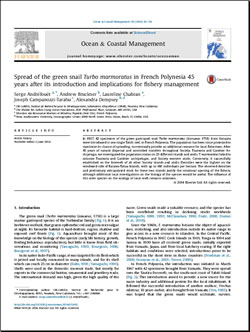Spread of the green snail Turbo marmoratus in French Polynesia
(2014)
This article on the spread of the green snail in French Polynesia published in Ocean & Coastal Management was a result of research conducted by Living Oceans Foundation Chief Scientist Andrew Bruckner and Coral Reef Ecologist Alexandra Dempsey with other mission team members Serge Andrefouet, Laureline Chabran, and Joseph Campanozzi-Tarahu during the Global Reef Expedition missions to French Polynesia.
Spread of the green snail Turbo marmoratus in French Polynesia 45 years after its introduction and implications for fishery management
Ocean & Coastal Management 96: 42-50
June 2, 2014
By Andrew Bruckner, Alexandra Dempsey, Serge Andrefouet, Laureline Chabran, and Joseph Campanozzi-Tarahu
Highlights
• Green snails were introduced 45 years ago in French Polynesia.
• Status of green snail population in 23 islands is updated.
• Population did not settle in Tuamotu, only in Society Archipelago.
• Abundance in Society justifies ospening fishery.
Abstract
 In 1967, 42 specimens of the green gastropod snail Turbo marmoratus (Linnaeus 1758) from Vanuatu were introduced in one single Tahiti reef, in French Polynesia. The population has been since protected to maximize its chance of spreading, to eventually provide an additional resource for local fishermen. After 45 years of natural dispersal and controlled transfers throughout Society, Tuamotu and Gambier Archipelago, we investigated the population status on 23 different islands and atolls. T. marmoratus failed to colonize Tuamotu and Gambier archipelagos, and Society western atolls. Conversely, it successfully established on the forereefs of all other Society islands and atolls. Densities were the highest on the windward side of Raiatea-Tahaa Islands, with up to 180 individuals per hectare. The observed densities and preliminary extrapolated stock for these two islands justify the rotational opening of the fishery, although additional local investigations on the biology of the species would be useful. The influence of this alien species on the ecology of local reefs remains unknown…
In 1967, 42 specimens of the green gastropod snail Turbo marmoratus (Linnaeus 1758) from Vanuatu were introduced in one single Tahiti reef, in French Polynesia. The population has been since protected to maximize its chance of spreading, to eventually provide an additional resource for local fishermen. After 45 years of natural dispersal and controlled transfers throughout Society, Tuamotu and Gambier Archipelago, we investigated the population status on 23 different islands and atolls. T. marmoratus failed to colonize Tuamotu and Gambier archipelagos, and Society western atolls. Conversely, it successfully established on the forereefs of all other Society islands and atolls. Densities were the highest on the windward side of Raiatea-Tahaa Islands, with up to 180 individuals per hectare. The observed densities and preliminary extrapolated stock for these two islands justify the rotational opening of the fishery, although additional local investigations on the biology of the species would be useful. The influence of this alien species on the ecology of local reefs remains unknown…